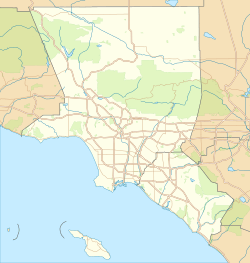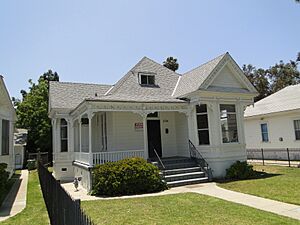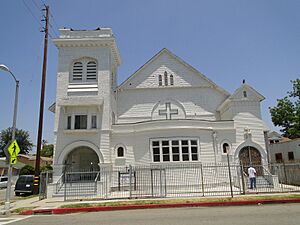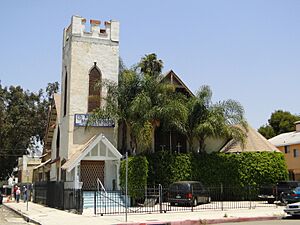27th Street Historic District facts for kids
Quick facts for kids |
|
|
27th Street Historic District
|
|
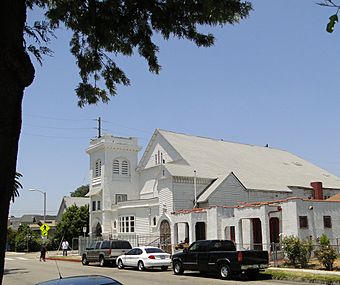
Crouch Memorial Church in 27th Street Historic District
|
|
| Location | 900–1030 E. 27th St., 1001–1036 E. 28th St., 1001 E. 29th St., Los Angeles, California |
|---|---|
| Architectural style | Various |
| MPS | African Americans in Los Angeles |
| NRHP reference No. | 09000399 |
| Added to NRHP | June 11, 2009 |
The 27th Street Historic District is a special area in South Los Angeles, Los Angeles, California. It's like a neighborhood that has been officially recognized for its important history. In 2009, this district was added to the National Register of Historic Places. This means it's a place worth protecting because of its connection to the history of African Americans in Los Angeles.
Contents
Exploring the District's Location and Buildings
This historic district is mainly found around East 27th Street and Paloma Avenue. It's just one block west of Central Avenue. The district includes 43 buildings that are important to its history. It also has 13 buildings that are not considered part of its historical significance. The area stretches south along Paloma Avenue to East 29th Street.
Homes in the Historic District
Most of the important buildings here are private homes. Many of these are beautiful Victorian Queen Anne style houses. They were built a long time ago, around the 1890s and early 1900s. You can also find homes built in the Colonial Revival and Transitional Craftsman styles.
Some of the notable homes include:
- 901 E. 27th Street – A Victorian Queen Anne style house from 1895.
- 909 E. 27th Street – Another Victorian Queen Anne style house from 1895.
- 912 E. 27th Street – A Victorian Queen Anne style house also built in 1895.
- 913–915 E. 27th Street – A Colonial Revival style duplex built in 1922.
- 920 E. 27th Street – A Transitional Craftsman style house from 1905.
- 925 E. 27th Street – A Colonial Revival style house built in 1895.
- 1002 E. 27th Street – A Victorian Queen Anne style house from 1895.
- 1008 E. 27th Street – A one-story cottage built in 1901.
- 1014 E. 27th Street – A Victorian Queen Anne style house from 1895.
- 1017 E. 27th Street – A cottage with Victorian details from 1895.
- 1020 E. 27th Street – A Victorian Queen Anne style house built in 1915.
- 1023 E. 27th Street – A cottage with Victorian details from 1898.
- 1013 E. 28th Street – A Transitional Craftsman style house from 1912.
- 1014 E. 28th Street – A Victorian Queen Anne style house built in 1893.
- 1001 E. 29th Street – An American Foursquare style home from 1895.
Important Community Buildings
The district also has two church buildings that are still standing today. They are called the Crouch Memorial Church of God and Christ and the Nueva Iglesia Bautista en Cristo. There is also a very important YMCA building. These church buildings have been used by many different groups over the years. This shows how the neighborhood has changed.
Crouch Memorial Church: A Look Back
The Crouch Memorial Church of God and Christ is part of this historic district. It's a Romanesque Revival style church. You can find it at the corner of E. 27th Street and Paloma Avenue. It was built between 1895 and 1896 for the Haven Methodist Episcopal Church.
In the early 1900s, this church was a big part of the city's movement against alcohol. In 1902, it hosted speeches and meetings for groups like the Anti-Saloon League and the Woman's Christian Temperance Union. In the early 1920s, the neighborhood started to change. The Haven Methodist church moved, and the building was sold to the Beth Eden Baptist Temple. This was an African-American church.
Nueva Iglesia Bautista en Cristo: A Church's Journey
The second important church building is now called the Nueva Iglesia Bautista en Cristo. It's a Gothic Revival style building. It stands at the corner of East 28th Street and Paloma Avenue. This church was built in 1906 for the Salem Congregational Church. This group served the white people who first lived in the area.
In 1911, this church was the first in Los Angeles to show "moving pictures" during sermons. This was a new and exciting way to teach! In 1917, an Armenian group bought the church. It became the Armenian Gethsemane Congregational Church. It served Armenian immigrants until 1944. Then, an African-American group bought it and named it the E. 28th Street Christian Church. Since 2003, it has been a Spanish-language church, serving the Hispanic community.
The 28th Street YMCA: A Place for Everyone
The 28th Street YMCA is also located within this historic district. This YMCA building was built in 1926. It was designed by a famous African American architect named Paul R. Williams. This YMCA was very important because it had a swimming pool for the African American community. At that time, many public swimming pools in the city did not allow Black people to swim there.
Why This District is Important
The 27th Street Historic District was added to the National Register of Historic Places in 2009. This happened because of a special study about African Americans in Los Angeles. The neighborhood was first settled by white residents. But its historical importance really began in 1923. That's when an African-American church bought the building at East 27th Street and Paloma Avenue. Around this time, African Americans started moving into the neighborhood. They built important cultural and business places along the nearby Central Avenue Corridor.
This district is special because it's one of the few neighborhoods along the Central Avenue area that still looks much like it did in the past. This makes it very important for understanding history. The Central Avenue Corridor became the main cultural and business center for the African-American community in Los Angeles from the 1920s to the 1950s. Other important buildings in this area include the Lincoln Theater, Second Baptist Church, and the 28th Street YMCA.
Gallery


